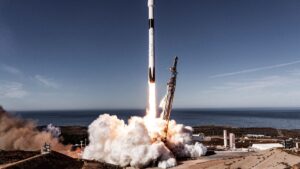
The Falcon 9 launch vehicle on Saturday put into orbit a batch of 21 mini-satellites to replenish the orbital constellation of the Starlink system’s global Internet coverage network, developer SpaceX said.
“On Saturday, February 8 at 2:18 p.m. ET (9:18 p.m. Kiev time), a Falcon 9 rocket launched 21 Starlink satellites into low-Earth orbit, including 13 with direct cellular access capability,” the company said in a statement on its website.
The rocket was launched from the 40th launch complex of the U.S. Space Force base at Cape Canaveral in Florida.
As part of the launch, the first reusable stage of the launch vehicle, which was used for the 17th time, made a controlled vertical landing on the offshore drone platform A Shortfall of Gravitas in the Atlantic after separation.
Since May 2019, SpaceX has already launched more than 7,800 such satellites as part of the Starlink project. Some of them failed or went out of orbit. More than 6.9 thousand vehicles are in orbit in working condition.
SpaceX is the largest satellite operator in the world. Starlink Internet network is available to users in 75 countries, including North and South America, Europe, Asia, Africa and Australia. According to the Pentagon, the services of these satellites are also actively used by the U.S. military.

A Falcon 9 rocket on Saturday (Kiev time) launched into orbit with a group of 51 research mini-satellites as part of the Transporter 7 mission, the carrier company SpaceX said.
The satellite group includes satellites from NASA, U.S. companies and research centers, as well as a number of foreign countries.
The launch took place from the SLC-4E launch pad at U.S. Space Force Base Vandenberg in California on Friday at 23:48 U.S. Pacific Coast Time (Saturday at 09:48 Kiev time).
As part of the launch, the first reusable stage of the Falcon 9 launch vehicle, which is in its tenth use, is scheduled to make a controlled vertical landing at Vandenberg Base about eight minutes after liftoff.

A Falcon 9 rocket on Sunday successfully injected another batch of 55 mini-satellites into orbit to replenish the orbital constellation of the Starlink global Internet coverage network, the developer SpaceX said.
“The launch of the 55 Starlink satellites has been confirmed,” the statement said.
The launch took place from the 40th launch pad of the U.S. Space Force Base at Cape Canaveral in Florida at 00:10 U.S. East Coast time (07:10 Kiev time).
About 1 hour and 4 minutes after the launch, the Starlink satellites separated from its second stage and entered a standard orbit.
This is the 73rd launch of a group of Internet satellites into orbit since May 2019 as part of the Starlink project and the fifth this year.
Including the current launch, SpaceX has already put more than 3,900 Starlink satellites into orbit. Some of them have malfunctioned or fallen out of orbit. Over 3.6 thousand devices remain in orbit in working condition.
Meanwhile, the first reusable stage rocket carrier rocket, which was used for the 12th time, about nine minutes after the launch made a vertical controlled landing on the sea platform drone A Shortfall of Gravitas, which was in the Atlantic at about 660 km from the launch pad.
In addition, a special rescue SpaceX vessel was to lift two fairing flaps of the rocket head part out of the water, which, after separation, descended by parachute. The re-use of the fairing saves SpaceX up to $6 million for its rocket launches.
The company is currently the largest satellite operator in the world. Internet from Starlink is available to users in 47 countries, including North America, Europe, the Far East and Australia. According to the Pentagon, the services of these satellites are also actively used by the U.S. military.
In the future SpaceX plans to deploy an orbital constellation of 12 thousand spacecraft (and in the future – from 30 thousand) to create a full-scale network, which will provide residents of the earth broadband Internet access anywhere in the world. The total amount of investments in implementation of the project is estimated at $10 billion.